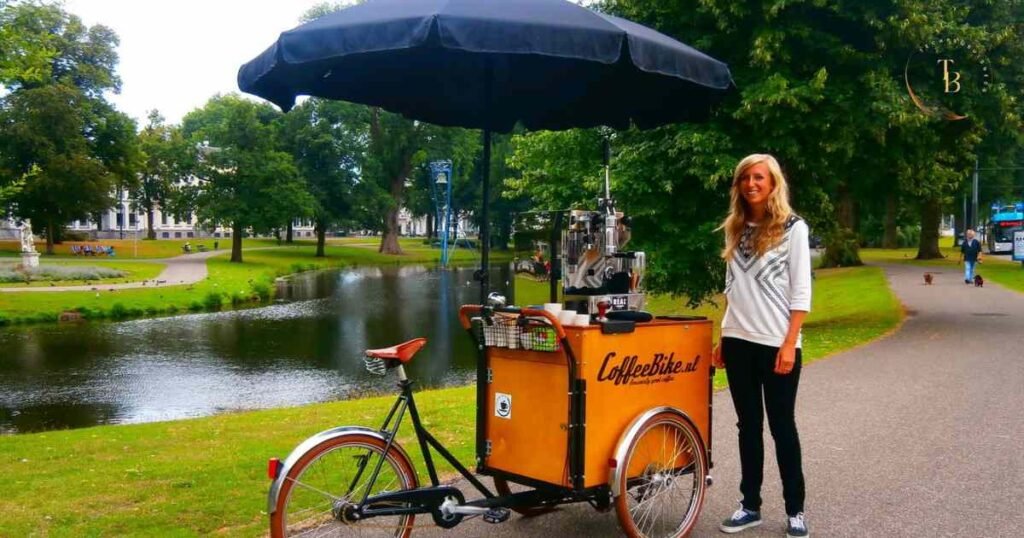In the bustling streets of today’s urban landscape, coffee has become more than just a drink. It’s a cultural phenomenon, a daily ritual for millions worldwide. As coffee culture continues to thrive coffee cart businesses emerge.
As a lucrative venture for entrepreneurs looking to tap into this ever-growing market. Whether you’re a seasoned barista or a novice entrepreneur. Starting a coffee cart business presents a golden opportunity to cater to caffeine enthusiasts on the go.
How to Start a Coffee Cart Business
Market Research
Before diving into the world of the coffee cart business, conduct thorough market research to identify potential opportunities and target demographics. Analyze local competition, consumer preferences, and popular locations to pinpoint areas with high demand and low saturation.

Legal Concerns: Navigating Regulations
Ensure compliance with local regulations and obtain necessary permits and licenses for operating a coffee cart business. From health and safety regulations to zoning laws and permits for food handling, understanding legal requirements is crucial for a seamless launch and long-term sustainability.
Equipment and Supplies: Investing in Quality
Invest in high-quality equipment and supplies to deliver exceptional coffee and service. From espresso machines and grinders to cups, lids, and condiments, prioritize durability, efficiency, and ease of use. Quality equipment not only enhances product consistency but also reflects positively on your brand image.
Location Strategy: Maximizing Foot Traffic
Strategically select locations with high foot traffic to maximize visibility and sales. Consider factors such as dull flow, nearby businesses, events, and parking availability. Collaborate with local businesses or event organizers to secure prime locations and capitalize on existing customer traffic.
Branding and Marketing: Building a Strong Presence
Create a compelling brand identity that vibrates with your target audience. From your logo and color scheme to packaging and signage, ensure consistency across all touchpoints. Leverage digital marketing channels, social media platforms, and local partnerships to increase brand awareness and attract customers.
Understanding the Mobile Coffee Cart Business

Embracing Mobility for Success
The concept of a mobile coffee cart business revolves around flexibility and accessibility. Unlike traditional cafes or brick-and-mortar establishments, mobile coffee carts can navigate various locations, targeting different demographics and events. This mobility offers unparalleled versatility, allowing you to capitalize on high-traffic areas such as business districts, parks, events, and festivals.
Crafting Your Unique Selling Proposition (USP)
In a saturated market, differentiation is key to success. Define your unique selling proposition (USP) to stand out amidst competitors. Whether it’s your signature blend, sustainable practices, or personalized customer experience, a compelling USP creates brand loyalty and sets you apart in the minds of consumers.
Coffee Cart Business Plan

Executive Summary: Setting the Stage
Begin your coffee cart business plan with a concise executive summary that outlines your business concept, objectives, target market, and unique selling proposition. This section serves as a snapshot of your venture, capturing the essence of your business and its potential for success.
Business Description: Important Your Vision
Provide a detailed overview of your coffee cart business, including its mission, vision, and core values. Describe your products and services, target market segments, competitive advantage, and long-term growth strategy. Highlight key milestones, achievements, and future expansion plans to convey a sense of confidence and competence.
Market Analysis: Identifying Opportunities
Conduct a comprehensive market analysis to assess industry trends, consumer preferences, and competitive landscape. Identify target demographics, market gaps, and emerging opportunities within the coffee industry. Utilize market research data to validate your business concept and inform strategic decision-making.
Marketing and Sales Strategy: Motivating Growth
Outline your marketing and sales strategy to attract customers and generate revenue. Define promotional tactics, pricing strategies, and distribution channels to reach your target audience effectively. Leverage digital marketing platforms, social media engagement, and community events to build brand awareness and drive customer engagement.
Financial Projections: Planning for Success
Develop realistic financial projections to estimate revenue, expenses, and profitability over the short and long term. Include startup costs, operating expenses, sales forecasts, and cash flow projections to demonstrate financial viability and sustainability. Utilize financial metrics and key performance indicators (KPIs) to track progress and make informed business decisions.
Operational Plan: Ensuring Efficiency
Detail your operational plan, including workflow processes, staffing requirements, and supply chain management. Define roles and responsibilities, training protocols, and quality control measures to ensure operational efficiency and consistency. Implement systems and procedures to streamline daily operations and maintain high standards of product and service delivery.
Risk Management: Justifying Challenges
Identify potential risks and challenges that may impact your coffee cart business and develop mitigation strategies to minimize their impact. From market fluctuations and regulatory changes to equipment malfunctions and supply chain disruptions, anticipate potential threats and proactively address them to safeguard business continuity.
Frequently Asked Questions (FAQs)

Q: What is a coffee cart business?
A coffee carts business is a mobile venture that specializes in serving coffee and related beverages to customers on the go. Unlike traditional cafes or coffee shops, coffee cart businesses operate from portable carts or trailers, allowing them to navigate various locations and cater to different demographics.
Q: How does a coffee cart business differ from a coffee shop?
While both coffee cart businesses and coffee shops serve coffee and related beverages, they differ in terms of mobility, size, and overhead costs. Coffee cart businesses are mobile and can operate from different locations, targeting events, festivals, and high-traffic areas. In contrast, coffee shops are stationary establishments with fixed locations and typically require higher overhead costs for rent, utilities, and staffing.
Q: What are the benefits of starting a coffee cart business?
Starting a coffee cart business offers several benefits, including:
- Mobility: Coffee cart businesses can navigate various locations, maximizing exposure and sales opportunities.
- Lower Overhead Costs: Compared to brick-and-mortar coffee shops, coffee cart businesses require lower overhead costs for rent, utilities, and staffing.
- Flexibility: Coffee cart businesses have the flexibility to adjust their operating hours and locations based on demand and seasonality.
- Targeted Marketing: Coffee cart businesses can strategically target specific demographics and events to maximize sales and customer engagement.
Q: What permits and licenses are required to start a coffee cart business?
The permits and licenses required to start a coffee cart business vary depending on location and local regulations. However, common requirements may include:
- Food Handler’s Permit: To ensure compliance with health and safety regulations for food preparation and handling.
- Business License: To legally operate a business within a specific jurisdiction.
- Mobile Vendor Permit: To operate a mobile food service business, such as a coffee cart.
- Zoning Permits: To ensure compliance with local zoning laws and regulations for operating a mobile food service business in designated areas.
Q: How do I choose the right location for my coffee cart business?
When choosing a location for your coffee cart business, consider factors such as:
- Foot Traffic: Select locations with high pedestrian flow, such as business districts, parks, and event venues.
- Visibility: Choose locations with high visibility and easy access to attract customers.
- Target Demographics: Identify your target market and select locations frequented by your ideal customers.
- Competition: Evaluate nearby competitors and choose locations with limited competition to maximize sales opportunities.
Q: What equipment do I need to start a coffee cart business?
The equipment needed to start a coffee cart business may include:
- Espresso Machine: To brew espresso-based beverages such as lattes, cappuccinos, and macchiatos.
- Coffee Grinder: To grind fresh coffee beans for brewing.
- Commercial Blender: To prepare blended coffee drinks and smoothies.
- Refrigeration Unit: To store milk, cream, and other perishable ingredients.
- Point-of-Sale (POS) System: To process orders and accept payments from customers.
Q: How can I differentiate my coffee cart business from competitors?
To differentiate your coffee cart business from competitors, consider:
- Unique Selling Proposition (USP): Identify what sets your coffee carts business apart from others, whether it’s your specialty drinks, sustainable practices, or personalized customer experience.
- Branding and Marketing: Develop a strong brand identity and leverage digital marketing channels, social media platforms, and local partnerships to increase brand awareness and attract customers.
- Product Innovation: Offer unique and innovative menu items, seasonal specials, and promotions to keep customers engaged and coming back for more.
Q: What are the key steps to writing a coffee cart business plan?
The key steps to writing a coffee cart business plan include:
- Executive Summary: Provide a brief overview of your coffee cart business, including its mission, vision, and objectives.
- Business Description: Describe your coffee carts business concept, target market, competitive advantage, and long-term growth strategy.
- Market Analysis: Conduct market research to identify opportunities, target demographics, and competitive landscape within the coffee industry.
- Marketing and Sales Strategy: Outline your marketing and sales tactics to attract customers and drive revenue.
- Financial Projections: Develop realistic financial projections to estimate revenue, expenses, and profitability over time.
- Operational Plan: Detail your operational processes, staffing requirements, and supply chain management.
- Risk Management: Identify potential risks and challenges and develop strategies to mitigate them for business continuity.






